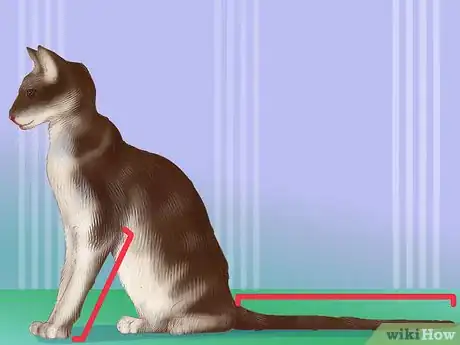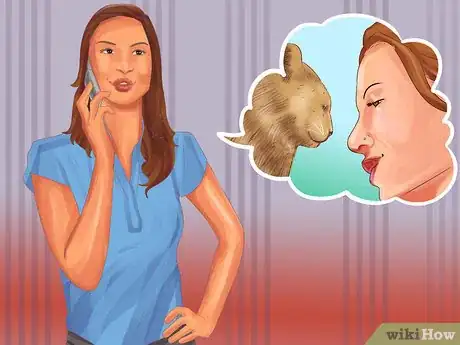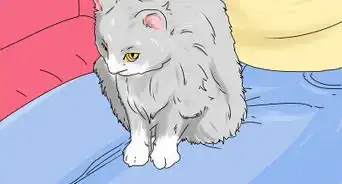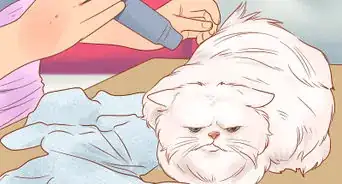This article was co-authored by Pippa Elliott, MRCVS. Dr. Elliott, BVMS, MRCVS is a veterinarian with over 30 years of experience in veterinary surgery and companion animal practice. She graduated from the University of Glasgow in 1987 with a degree in veterinary medicine and surgery. She has worked at the same animal clinic in her hometown for over 20 years.
This article has been viewed 28,427 times.
Oriental cats have unique appearances and personalities. However, Siamese cats and some mixed breed cats may resemble them. Fortunately, there are enough traits and characteristics unique to the breed that you should be able to identify an Oriental cat with little effort. By observing the cat’s build, watching its behavior, and possibly by consulting a professional, you’ll be able to better identify an oriental cat.
Steps
Observing the Cat’s Physical Attributes
-
1Notice their slender, elegant body shape. Oriental cats, much like Siamese cats, have a unique body frame that is often described as sleek or graceful. Thus, they’re relatively easy to tell apart from different cat breeds.
- They have a long torso, neck, legs, and tail.
- They have an angular head.
- Their ears are relatively large and flaring.
- Oriental cats are also medium sized and may range from 6 to 12 pounds.[1]
-
2Look for a lot of hair and color variation. As opposed to the Siamese cat, Oriental cats have many more color variations. In addition, Orientals come in both shorthair or longhair varieties. Some of the most important characteristics of the Oriental’s hair and color include:
- They come in more than 300 color variations. However, the most common colors are ebony, white, chestnut, or blue. This is opposed to Siamese cats come in about 4 different variations, including seal, chocolate, blue, and lilac point.
- They can be both short and medium-haired. However, short-haired variants are much more common.
- Their hair may appear glossy.
- They have solid, tabby, or bi-color patterns.[2]
Advertisement -
3Observe blue or green almond-shaped eyes. Combined with their length, the color and shape of the Oriental’s eyes make it a unique attribute that will help you identify them. Ultimately, much like with other attributes, the eyes of Oriental cats are much like the eyes of Siamese cats.
- Most oriental cats have blue or green eyes.
- White Orientals could have blue or odd colored eyes.
- Pointed oriental cats have blue eyes.[3]
Watching the Cat’s Behavior
-
1See if the cat is attached to its owner. Unlike some other breeds of cats, many Orientals demonstrate a close attachment to their owners. They often manifest this with affection and by staying close to their people.
- Orientals will follow their owners around relentlessly.
- They may seem as if they are needy or are very interested in what you are doing.
- If you don’t pay attention to them, they’ll be very vocal about getting your attention.[4]
-
2Notice that the cat is very social. Oriental cats are exceptionally social animals. They have a reputation for being very vocal and talkative, and they’ll often make noises, assert themselves, and be very interactive. This contrasts to other cats that may be more solitary and quiet.
- The cat may play games, like fetch, with children.
- They may get along with other cats and even dogs.
- They like to be around people. For example, if you have a gathering, your oriental might make the rounds and introduce itself to your friends and family.[5]
-
3Watch for signs of extreme curiosity. Orientals are very curious. This, along with their intelligence, means that you should notice a level of inquisitiveness that you might not notice with typical house cats.
- Make sure to secure parts of your home that are dangerous. Orientals are adept at opening drawers or even doors.
- Secure your purse or wallet, as they might open them up and play with the contents.
- Try to keep them entertained with games, toys, and by playing with them. Entertainment is a great way to positively channel their curiosity.[6]
Consulting Professionals
-
1Ask a breeder. Breeders of Oriental or Siamese cats are perhaps the best authorities to consult when trying to identify an Oriental. They’ll be able to take important factors into account, like the cat’s body type, color, and personality.
- If you own a Siamese or Oriental, contact the breeder you adopted it from. They should be happy to help you confirm whether another cat is or is not an Oriental.
- Run an internet search for breeders of Orientals or Siamese cats in your area. Call them and ask if they’ll help you identify a cat.
- If you have trouble finding a breeder in your area, you may be able to contact one in another region who will look at photos and give you their assessment.[7]
- If you want to adopt an Oriental cat from a breeder, make sure to ask them for the pedigree paperwork for the parents of the cat, as this details their lineage and proves that they’re truly Oriental.
-
2Talk to your vet. Next to a breeder, your vet is the most qualified professional to help identify an oriental cat. Ultimately, your vet’s substantial experience will be an asset.
- Call your vet and see if you can bring the cat by for quick identification. While some vets may require an appointment, others may be happy to take a quick look.
- If you don’t own the cat in question, take pictures and ask your vet if they’ll look at the photos.
-
3Pay for a DNA test. If you’re still unsure that a specific cat is an Oriental, you can choose to run a DNA test on your cat. The DNA test will tell you without a doubt whether the cat is a purebred or not.
- The DNA test will give you an idea of the breeds of cats in your cat’s bloodline.
- Visit popular websites like animalsdna.com, vetdnacenter.com, or catdnatest.org for more information on testing a specific cat.
- As there are many DNA tests commercially available, make sure to confirm that one you choose will verify the specific breed of your cat. If trying to determine the difference between a Siamese and Oriental cat, it may be best to call the vendor to verify the test will work.[8]
References
- ↑ http://cfa.org/Breeds/BreedsKthruR/Oriental.aspx
- ↑ http://www.petmd.com/cat/breeds/c_ct_oriental
- ↑ http://www.hillspet.com/en/us/cat-breeds/oriental
- ↑ http://www.vetstreet.com/cats/oriental#personality
- ↑ http://www.vetstreet.com/cats/oriental#personality
- ↑ http://cfa.org/Breeds/BreedsKthruR/Oriental.aspx
- ↑ http://www.breedlist.com/breeders/oris.html
- ↑ https://www.vgl.ucdavis.edu/services/cat/
About This Article
To identify an Oriental cat, check if it has a long, sleek body shape and an angular head. When assessing the cat’s appearance, you can also look for blue or green almond-shaped eyes. Since Oriental cats like having a close attachment with their owners, observe whether the cat is affectionate, needy, interactive, or simply very interested in what you’re doing. This breed of cat is also known to be quite vocal, so pay attention to whether it makes a lot of noises. If you need more help figuring out if a cat is an Oriental, you can contact the breeder you got it from or consult another Oriental breeder. For more tips from our Veterinary co-author, including how to get a DNA test to tell if your cat is a purebred Oriental, read on!




































































